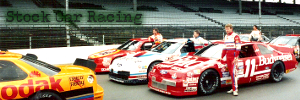















Random Lugnuts: We Need More Short Tracks, Less Daytona |
|---|
 What is Random Lugnuts? It's random bits of stock car racing commentary written on an irregular basis by an irregular racing fan. The name is a reference to the lugnuts that go flying off a car during a pit stop: you never know where they are going to go, what they're going to do when they get there, they can be annoying, they're often useless after a race, and every once in a while someone gets hit and they don't know exactly where it came from.
What is Random Lugnuts? It's random bits of stock car racing commentary written on an irregular basis by an irregular racing fan. The name is a reference to the lugnuts that go flying off a car during a pit stop: you never know where they are going to go, what they're going to do when they get there, they can be annoying, they're often useless after a race, and every once in a while someone gets hit and they don't know exactly where it came from.
Opinions expressed by Bill Crittenden are not official policies or positions of The Crittenden Automotive Library. You can read more about the Library's goals, mission, policies, and operations on the About Us page.
|
Bill Crittenden
February 24, 2015
Despite being the crown jewels of American motor racing, huge tri-oval tracks have been pits of controversy since restrictor plates were mandated by NASCAR at Daytona and Talladega in 1988. Since then it's been one great bitching session after another about the racing: drafting causing pile-ups, the inevitable "Big One," injuries, cars flying into the fence, the death of Dale Earnhardt, bump drafting, tandem drafting, the old Car of Tomorrow wings lifting the cars up, roof flaps, escape hatches, rollover wrecks and the bane of every old-school NASCAR fans' existence known as the "common template" car which was mandated for safety standards.
It's been fun to fill the air and the message boards over the years, but now it's just getting tiring to rehash the same old issues year after year. Sure, there are up years and down years, but even in an up year like 2015 there are still a lot of disgruntled fans. This year's complaint seems to be about a three-wide three-hour follow the leader punctuated by a big wreck, another red flag wait, and then the finish. I've heard this story before.
On the other hand, Bristol is still a hugely fun event that almost nobody whines about, and bringing the Cup Series to a dirt race at Eldora is the dream of many fans. As I always say when the name Bristol is invoked, why couldn't THAT have been the mold for all the "cookie cutter" tracks? I'm really sad it wasn't. Could you imagine a schedule full of all sorts of different half-mile bullring tracks?
Daytona and Talladega and Michigan and pretty much anything bigger than a mile and a half are throwbacks to the era when stock car racing was a test of factory(ish) machines by daredevil racers who risked death every weekend. But as the speeds of purpose-built race cars exceeded the limits of the safety equipment of both car and racetrack, the cars have had to have been artificially slowed down.
That brings us to the era of modern restrictor plate racing and all its attendant controversies. Even going slower than what the cars are truly capable of, it's not entirely safe, as fan injuries from flying cars and Kyle Busch's recent injury show us.
I know NASCAR is a sport steeped in traditions its fans hold as dear to their hearts as their family honor, so I don't actually expect Daytona to be let go from the schedule in my lifetime even if I make it to 100. But the handful of races at its biggest tracks aren't its only cherished annual events. Short track racing is a fan favorite, and some of the sport's best action coming from its smallest venues. These events could use some emphasis from the sport's publicity and PR folks because it's the short tracks that continue to produce the sort of bitch-session-free "rubbin' is racin'" action that got NASCAR its fans to begin with.
We have to remember that NASCAR's draw isn't its speed, if top speeds were what drew fans stock cars would be hopelessly out-rated by the NHRA and IndyCar. It's certainly not its cars, vague silhouettes of family cruisers that include the most bland and boring sedan on the market: the Toyota Camry. It's biggest draws are side-by-side racing and personality, both of which can be showcased in wheel-to-wheel racing at Martinsville or Bristol or Iowa or New Hampshire or Phoenix or Milwaukee.
